16.4: Marine Reptiles
- Page ID
- 10419
\( \newcommand{\vecs}[1]{\overset { \scriptstyle \rightharpoonup} {\mathbf{#1}} } \)
\( \newcommand{\vecd}[1]{\overset{-\!-\!\rightharpoonup}{\vphantom{a}\smash {#1}}} \)
\( \newcommand{\dsum}{\displaystyle\sum\limits} \)
\( \newcommand{\dint}{\displaystyle\int\limits} \)
\( \newcommand{\dlim}{\displaystyle\lim\limits} \)
\( \newcommand{\id}{\mathrm{id}}\) \( \newcommand{\Span}{\mathrm{span}}\)
( \newcommand{\kernel}{\mathrm{null}\,}\) \( \newcommand{\range}{\mathrm{range}\,}\)
\( \newcommand{\RealPart}{\mathrm{Re}}\) \( \newcommand{\ImaginaryPart}{\mathrm{Im}}\)
\( \newcommand{\Argument}{\mathrm{Arg}}\) \( \newcommand{\norm}[1]{\| #1 \|}\)
\( \newcommand{\inner}[2]{\langle #1, #2 \rangle}\)
\( \newcommand{\Span}{\mathrm{span}}\)
\( \newcommand{\id}{\mathrm{id}}\)
\( \newcommand{\Span}{\mathrm{span}}\)
\( \newcommand{\kernel}{\mathrm{null}\,}\)
\( \newcommand{\range}{\mathrm{range}\,}\)
\( \newcommand{\RealPart}{\mathrm{Re}}\)
\( \newcommand{\ImaginaryPart}{\mathrm{Im}}\)
\( \newcommand{\Argument}{\mathrm{Arg}}\)
\( \newcommand{\norm}[1]{\| #1 \|}\)
\( \newcommand{\inner}[2]{\langle #1, #2 \rangle}\)
\( \newcommand{\Span}{\mathrm{span}}\) \( \newcommand{\AA}{\unicode[.8,0]{x212B}}\)
\( \newcommand{\vectorA}[1]{\vec{#1}} % arrow\)
\( \newcommand{\vectorAt}[1]{\vec{\text{#1}}} % arrow\)
\( \newcommand{\vectorB}[1]{\overset { \scriptstyle \rightharpoonup} {\mathbf{#1}} } \)
\( \newcommand{\vectorC}[1]{\textbf{#1}} \)
\( \newcommand{\vectorD}[1]{\overrightarrow{#1}} \)
\( \newcommand{\vectorDt}[1]{\overrightarrow{\text{#1}}} \)
\( \newcommand{\vectE}[1]{\overset{-\!-\!\rightharpoonup}{\vphantom{a}\smash{\mathbf {#1}}}} \)
\( \newcommand{\vecs}[1]{\overset { \scriptstyle \rightharpoonup} {\mathbf{#1}} } \)
\( \newcommand{\vecd}[1]{\overset{-\!-\!\rightharpoonup}{\vphantom{a}\smash {#1}}} \)
\(\newcommand{\avec}{\mathbf a}\) \(\newcommand{\bvec}{\mathbf b}\) \(\newcommand{\cvec}{\mathbf c}\) \(\newcommand{\dvec}{\mathbf d}\) \(\newcommand{\dtil}{\widetilde{\mathbf d}}\) \(\newcommand{\evec}{\mathbf e}\) \(\newcommand{\fvec}{\mathbf f}\) \(\newcommand{\nvec}{\mathbf n}\) \(\newcommand{\pvec}{\mathbf p}\) \(\newcommand{\qvec}{\mathbf q}\) \(\newcommand{\svec}{\mathbf s}\) \(\newcommand{\tvec}{\mathbf t}\) \(\newcommand{\uvec}{\mathbf u}\) \(\newcommand{\vvec}{\mathbf v}\) \(\newcommand{\wvec}{\mathbf w}\) \(\newcommand{\xvec}{\mathbf x}\) \(\newcommand{\yvec}{\mathbf y}\) \(\newcommand{\zvec}{\mathbf z}\) \(\newcommand{\rvec}{\mathbf r}\) \(\newcommand{\mvec}{\mathbf m}\) \(\newcommand{\zerovec}{\mathbf 0}\) \(\newcommand{\onevec}{\mathbf 1}\) \(\newcommand{\real}{\mathbb R}\) \(\newcommand{\twovec}[2]{\left[\begin{array}{r}#1 \\ #2 \end{array}\right]}\) \(\newcommand{\ctwovec}[2]{\left[\begin{array}{c}#1 \\ #2 \end{array}\right]}\) \(\newcommand{\threevec}[3]{\left[\begin{array}{r}#1 \\ #2 \\ #3 \end{array}\right]}\) \(\newcommand{\cthreevec}[3]{\left[\begin{array}{c}#1 \\ #2 \\ #3 \end{array}\right]}\) \(\newcommand{\fourvec}[4]{\left[\begin{array}{r}#1 \\ #2 \\ #3 \\ #4 \end{array}\right]}\) \(\newcommand{\cfourvec}[4]{\left[\begin{array}{c}#1 \\ #2 \\ #3 \\ #4 \end{array}\right]}\) \(\newcommand{\fivevec}[5]{\left[\begin{array}{r}#1 \\ #2 \\ #3 \\ #4 \\ #5 \\ \end{array}\right]}\) \(\newcommand{\cfivevec}[5]{\left[\begin{array}{c}#1 \\ #2 \\ #3 \\ #4 \\ #5 \\ \end{array}\right]}\) \(\newcommand{\mattwo}[4]{\left[\begin{array}{rr}#1 \amp #2 \\ #3 \amp #4 \\ \end{array}\right]}\) \(\newcommand{\laspan}[1]{\text{Span}\{#1\}}\) \(\newcommand{\bcal}{\cal B}\) \(\newcommand{\ccal}{\cal C}\) \(\newcommand{\scal}{\cal S}\) \(\newcommand{\wcal}{\cal W}\) \(\newcommand{\ecal}{\cal E}\) \(\newcommand{\coords}[2]{\left\{#1\right\}_{#2}}\) \(\newcommand{\gray}[1]{\color{gray}{#1}}\) \(\newcommand{\lgray}[1]{\color{lightgray}{#1}}\) \(\newcommand{\rank}{\operatorname{rank}}\) \(\newcommand{\row}{\text{Row}}\) \(\newcommand{\col}{\text{Col}}\) \(\renewcommand{\row}{\text{Row}}\) \(\newcommand{\nul}{\text{Nul}}\) \(\newcommand{\var}{\text{Var}}\) \(\newcommand{\corr}{\text{corr}}\) \(\newcommand{\len}[1]{\left|#1\right|}\) \(\newcommand{\bbar}{\overline{\bvec}}\) \(\newcommand{\bhat}{\widehat{\bvec}}\) \(\newcommand{\bperp}{\bvec^\perp}\) \(\newcommand{\xhat}{\widehat{\xvec}}\) \(\newcommand{\vhat}{\widehat{\vvec}}\) \(\newcommand{\uhat}{\widehat{\uvec}}\) \(\newcommand{\what}{\widehat{\wvec}}\) \(\newcommand{\Sighat}{\widehat{\Sigma}}\) \(\newcommand{\lt}{<}\) \(\newcommand{\gt}{>}\) \(\newcommand{\amp}{&}\) \(\definecolor{fillinmathshade}{gray}{0.9}\)Marine Reptiles
Compared with the number of reptiles groups and species on Earth, relatively few are adapted to marine environments. The earliest marine reptiles appear in the Permian Period. Many groups emerged in the Mesozoic Era including more familiar varieties including ichthyosaurs, plesiosaurs, and mosasaurs. Many varieties of the Mesozoic Era vanish at the K/T Boundary extinction.
| CLASS |
Reptilians |
|
| ORDER | Crocodiles | |
| ORDER | Lizards | |
| ORDER | Sea Turtles | |
| ORDER | Sea Snakes | |
Crocodiles
There are 23 living crocodilian species in both terrestrial aquatic and coastal marine environments. Crocodilians are found in the tropical to subtropical regions on all continents (not Antarctica); they're found in over 90 countries and islands. They are unable to survive and reproduce successfully in cold climates.
| What's the difference between an alligator and a crocodile? | |
American Alligator |
American Crocodile |
| Habit: feisty | Habit: more feisty, but shy and reclusive |
| Habitat: freshwater to brackish water | Habitat: brackish to salt water |
| Color: gray to black | Color: greenish gray |
| Encounters with humans: common | Encounters with humans: not so common |
| Diet: most everything, fish, birds, pets | Diet: mostly fish |
| Maximum size: `12 feet | Maximum size: ~13 feet |
| Characteristics: Alligators snout is blunt and shovel like (used like a shovel too) | Characteristics: Crocodile snout is pointed with more teeth sticking out (better for catching fish) |
| Range in US: Gulf & Atlantic coasts (TX to SC) | Range in US: South Florida only |
| Example: Figure 16.25 | Example: Figure 16.26 |
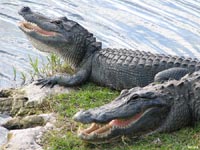 |
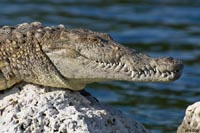 |
| Figure 16.24. Alligator | Figure 16.25. Crocodile |
Marine Lizards
The only marine lizard is the Galápagos marine iguana (Amblyrhynchus cristatus)—found only on the Galápagos Islands. This iguana lives along rocky island shorelines and can dive over 9 m (30 ft) into the water to forage for its main diet of red and green algae (Figure 16.27).
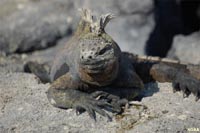
Extinct Large Marine Reptiles
Aquatic reptiles first noted from the Permian Period. There were many varieties of large marine reptiles during the Mesozoic Era. All vanished at the end of the Cretaceous Period (about 65 million years ago).
Ichthyosaurs: Triassic to Late Cretaceous
Plesiosaurs: Early Jurassic - Late Cretaceous
Mosasaurs: Late Cretaceous
The ancient marine reptiles illustrated convergent evolution - they had terrestrial ancestors like dolphins and whales.

Sea Turtles
There are seven species of sea turtles worldwide. Sea turtles sea turtles can be found in all oceans except for the polar regions, along the continents shelves and islands. They are known to nest in more than 80 countries. Sea turtles first appear in the geologic record in early Cretaceous time (land proto-turtles appeared in Permian time).
Unlike land turtles, sea turtles are unable to pull their heads or appendages into their shells. Sea turtle shells are lighter and more hydrodynamic than terrestrial turtle shells. There flippers enable them to swim long distances. Male sea turtles spend their entire lives at sea. Females return to the same beaches they were born on about every two years to lay eggs.
All adult green sea turtles are herbivores, feeding on algae, sea grasses, and other vegetation. Juvenile are carnivorous, feeding on jellies and other invertebrates. Large adult green sea turtles can weigh upward of 400 pound and over 1 meter.
Leatherback turtles are carnivorous, migrating thousands of miles each year to feed on jellyfish.
Leatherback Turtles can weigh as much as 1500 pounds and reach lengths of over 2 meters.
Sea TurtlesGreen sea turtleLeatherback sea turtle Loggerhead sea turtle |
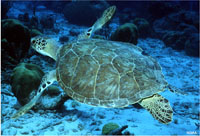 |
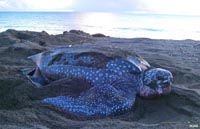 |
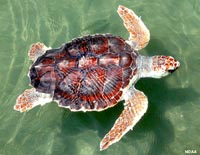 |
| Figure 16.28. Green sea turtle | Figure 16.29. Leatherback sea turtle | Figure 16.30. Loggerhead sea turtle. |
Sea Snakes
There are about 50 species. They live in tropical waters of the west Pacific Ocean, around Australia, and in the Indian Ocean. Sea snakes inhabit marine environments for most or all their lives. Sea snakes are generally non aggressive, brightly colored, with small mouth and fangs. Sea snakes have very powerful venom. An average of about 20 deaths per year happen from fishermen trying to remove them from nets.



